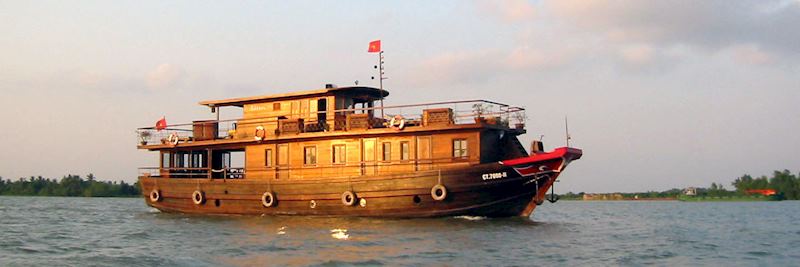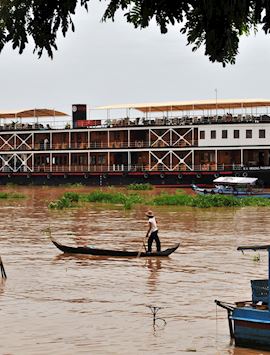By Indochina specialist Mark
At the tail end of its journey from the Tibetan plateau to the sea, the Mekong meanders through Indochina. As it cleaves its path roughly from north to south, with many contours along the way, it flows through Laos, Cambodia and finally Vietnam.
These three of the region's most popular countries are intrinsically linked by the river, and cruising is an extremely peaceful way to explore the rhythm of life among the many people living on or around the water, fishing in the tributaries and using the Delta as a major trade route.
Cruising in Indochina isn't just confined to the Mekong, though. Over the course of a few days or even a week a cruise provides an alternative angle for exploring local culture and landscapes at a relaxed pace. That's whether you're negotiating the Red River as it drifts past remote tribal communities, or snaking through the towering limestone karsts of Halong Bay.
Cruises on the Mekong in Indochina
Week-long cruise from Vietnam to Cambodia

A perennially popular cruise option in Indochina is a seven-day trip that takes you from Vietnam's original 'Pearl of the Orient', Ho Chi Minh City, to bustling Siem Reap in Cambodia, the gateway to the temples of Angkor.
Heading upstream along the Mekong, you pass through the Delta into Cambodia where the river hugs the charming capital, Phnom Penh, before finishing in Siem Reap.
The Mekong is the lifeblood of Indochina, and working boats form a continuous convoy, carrying anything from logs, to food or scrap metal.
At certain times of the year, it's also possible to spend part of this cruise on Tonle Sap, the largest freshwater lake in Southeast Asia.
The lake is home to Cambodia's floating villages and it's quite strange to see fully functioning homes and businesses that have evolved around living on this huge expanse of water. All the buildings are built on stilts and the best time to visit is from October to January when the water levels are high, and the villages seemingly float on the surface.
I'd recommend incorporating this cruise into at least a two-week trip, to give ample time to explore Ho Chi Minh City and the temples at Angkor Wat either side of your time on board.
Two or three-day Mekong cruise in Vietnam

If you don't have a week to spare to cruise the Mekong, there are shorter boat trips that still journey through the very heart of the Delta. These cruises usually concentrate on Can Tho and Cai Be, market towns in southern Vietnam. Can Tho is home to Cai Rang, the largest floating market on the Delta.
The Delta usually pervades a tranquil air through its wooden floating villages. But each morning the Delta snaps into a frenzy of commerce as the Cai Rang floating market gathers.
The first sights, and sounds, of the market are the stuff of enduring memories. During a recent trip, I was awoken at 6am to the sounds of traders. Heading up to my boat's sundeck, boats as far as the eye could see greeted me, all bartering with each other trading in fruit, vegetables and rice.
After breakfast, you can sail in a smaller boat to join the organised chaos. I'd advise trying your hand at a bit of light bartering, for an ice tea or some fresh fruit. Usually, the ice tea will be hand delivered in a plastic bag with a straw poking out the top.
Colonial architecture dots the Mekong Delta region and a nice option is to combine a cruise with time in Can Tho.

On the Mekong Delta, many of the cruise vessels once transported rice. These converted barges can now accommodate up to 15 passengers.
Cabins are fairly basic and compact, but not without a few comforts, such as air conditioning and en suite facilities.
My choice of boats for cruising these waters are the vessels of the R/V Bassac fleet. These small barges have the appearance of being built using just the materials to hand and there's a real focus on service and providing an authentic Delta experience on board.
Two-day Mekong cruise in Northern Laos

The section of the Mekong from the Thai border to Luang Prabang, Laos’s spiritual heart, is wild and fast-flowing. This remote stretch is my favourite for cruising in Indochina, purely for its setting. The river dissects jungle-access mountains, sheer cliff faces abut the water and boats provide the only means to small riverside villages and hill tribe communities.
Your mode of transport is a traditional long tail boat, narrow vessels equipped to negotiate the shallow waters of the region.
Even villages just across the river from one another can differ significantly, with different minority tribes embracing completely contrasting ways of life, such as the H'mong, Tai, Yao and Akha minorities. Stopping at communities along the way gives a first-hand perspective on local life and trades.
The boats have room for up to 40 passengers plus local guides, but they manage to avoid feeling overcrowded. Set up with rows of two seats either side of the aisle and umbrellas overhead for shade, the atmosphere is nice and convivial. You'll be able to enjoy drinks at your table and chat to fellow guests.
Unusually, you stay overnight onshore in a lodge situated in a small Laotian village perched on the hillside. The enviable views crescendo at dusk as the sun drifts below the mountains.
The lodge, while basic, has its charm and it gives an edge of adventure as well as en suite rooms, hot water, and an open-air restaurant and bar.
Cruise through the 4,000 Islands in Southern Laos

As the Mekong hits the Si Phan Don archipelago, or 4,000 Islands, in Southern Laos it swells to its widest to navigate these natural obstacles. The islands form a riverine archipelago, so-called because of how the water channels around the inlets.
The Vat Phou, a 12-cabin converted teak barge, is an enchanting option for a boat trip in this laid-back pocket of Laos. The cruise starts from the southern tip of the 4,000 Islands on the border with Cambodia, where the Mekong drops off through a series of waterfalls.
You spend three days on board, criss-crossing between the islands and stopping off at the pre-Angkorian Wat Phou temple as well as the market town of Pakse. From here you can continue your journey by car to Central Laos, or fly to Cambodia.
The boat is named after the temple, which is set just back from the banks of the Mekong. An ancient road links Wat Phou and Angkor Wat, hinting to the connection between the people of these two archaeological sites.
Food on board the Vat Phou is traditionally Laotian and you can expect dishes such as lap, a spicy salad. Fruit and seafood are plentiful in this area and also feature regularly on the menu.
Two or three-day cruises in Halong Bay, Vietnam

To jump on a boat is the only real way to explore the waterways of Halong Bay, a designated UNESCO World Heritage Site. A cruise in the bay is always a popular choice (and with it, a busy one), but it's top of the 'to-do' list with good reason. Many travellers want to wonder at its soaring limestone karsts from the emerald waters.
While Halong City is the gateway to the bay, you can't actually see anything of it from here. Cruises take two or three hours to get in among the thousands-strong islands, and this is where they really come to life.
Small and large boats, with from one to 20 cabins, are available for cruises in Halong Bay. There are benefits to both, depending on your preferences. Some of the bigger vessels house an impressive list of amenities including splash pools, restaurants, air conditioning, bars and different room types. While on the smaller vessels you've a degree more flexibility over the course you take.
Boats are traditionally styled Vietnamese wooden junks with large sails, most of them original, which the captain will raise on a calm day.
But where the boats really excel is in with the activities they offer to help you explore nearby islands. Kayaking, fishing, trekking and cycling are just some of what's available.
I spent time aboard the Indochina Sails and with a guide kayaked to Titov Beach, a crescent around the base of one of the bay's islands. Here I climbed a few hundred steps to reach the clifftop. The steps are carved into the rock and a decent level of fitness is required to climb them, but once at the top I was silenced by a view of Halong Bay, sought after by so many.
Ten days on the Red River in Vietnam

The Red River meanders down through China into the heart of Hanoi, finally flowing into the waters of Halong Bay. Cruising is still new to the ruddy-brown waters that give the river its name. Pandaw is the only fleet currently offering this route, using the colonial-style RV Angkor Pandaw.
I'd suggest a Red River cruise to any returning traveller to Vietnam as a great way to combine time in Hanoi with visiting hill tribes amid Mai Chau, an isolated farming region slowly opening up to visitors.
Best time to cruise in Indochina
The best time to embark on a boat trip in Indochina is just after the rainy season, from October until January. The water levels will be at their peak and if you go early enough you'll find the routes are generally quiet. If you're tied to travelling in spring, it's possible to cruise right up until the end of March.
The temperature at this time of the year will be around the high twenties in southern Cambodia and Vietnam. Further north, it will hit the mid-thirties.
Given the small window for travel, It's advisable to book your cruising trip as far in advance as possible. Compared with journeys by land in Southeast Asia where there's almost a bewildering selection of hotels to choose from, cabin space on cruise ships is limited.
Plan your cruise to Indochina
-
![RV Mekong Pandaw]()
-
![Mekong River near Luang Prabang]()
-
![Borobudur, Yogyakarta]()
Bali to Bangkok: Southeast Asia by luxury cruise
Vietnam, Indonesia, Thailand and CambodiaView this tour
Start thinking about your experience. These itineraries are simply suggestions for how you could enjoy some of the same experiences as our specialists. They're just for inspiration, because your trip will be created around your particular tastes.
View All Tours in Southeast Asia



